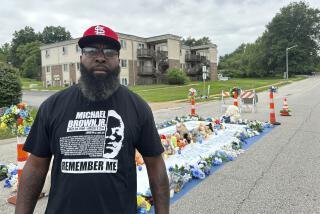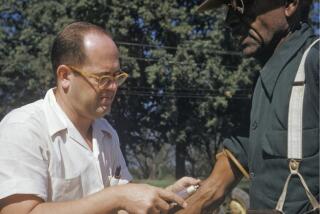Blacks Feel Unwelcome Among Whites : Socially, Color Line Is Still Drawn in Nation’s Capital
WASHINGTON — When this city recently celebrated the lavish renovation of its Union Station, limousines lined up at the curbs outside the elegant old train terminal and richly dressed men and women partied into the night. Although the vast majority of Washingtonians are black, the huge main waiting room was a sea of white faces--with only occasional flecks of black here and there.
Last fall, about 200 people attended a stately reception at the Smithsonian Institution’s National Museum of American History. About a dozen were black.
These scenes illustrate a striking reality, one mirrored in many cities across America: Although they have had decades of increased familiarity with each other, through jobs and public facilities integrated by law, blacks and whites in many social settings seem further apart than ever.
“The manner in which we socialize has not improved, in spite of the law,” said Kenneth Daugherty, a black man who is theater manager for the Duke Ellington School of the Arts. “We have not been able to legislate that.”
This apartness is particularly striking here in the District of Columbia. With a population of 628,500, it is 70% black, so black that people of color long ago nicknamed it “Chocolate City.”
Yet, the crowds that gather in many places here--the Kennedy Center, expense account restaurants on K Street, glittering receptions on Capitol Hill and soirees in Georgetown--would make one think that this is “Vanilla City.”
Meanwhile, blacks predominate at other social centers--black-oriented plays, black-run nightclubs and at restaurants oriented to black people.
Thus, the nation’s capital serves less as a model of racial harmony than as proof that social integration remains a slow-moving dream.
“I’m always amazed at how segregated events are,” said Brett Williams, an American University anthropology professor, who is white. “People used to seek integrated situations, but today they have given up.”
Had Southern Attitudes
The apartness reflects an identity crisis that historically has afflicted the District of Columbia. As the federal city, it was supposed to lead the national integration effort; but, because it was also a city of old Southern attitudes, it lagged behind other areas.
Now, 20 years after Washingtonians were torn apart by the burning and looting that followed the murder of Dr. Martin Luther King Jr., they are still divided.
Washington “has a history of being a segregated city. People remember that and feel strange going to some places,” Williams said.
The result is a city in which people of opposite colors do not know each other. This situation may cost whites some cultural experiences, but blacks stand to lose much more. In a “power city” like Washington, it is generally believed that social contacts are essential to career enhancement, that much work is accomplished during play.
Key Role for Social Life
Jacqueline Trescott, a Washington Post writer who has reported for 18 years on the ups and downs of Washington’s key social players, said capital parties and other social events “play a very special role in how a person is perceived--whether he can get along with others . . . . It’s still a very important means by which white people evaluate black people.”
But, because so few black people make it to the major social events here, there are not many to evaluate. Increasing numbers of blacks have been hired in the city’s thousands of offices, but they are most visible in low-level jobs: Museum guards seem always to be black, and blacks are far more likely to be secretaries and janitors than executives in any building in town. This division prompts many here to call Washington “the plantation.”
Why is Washington so segregated socially?
Washington Mayor Marion Barry contends that, in some cases--at private parties given by corporations and individuals, for example--white hosts exclude blacks from the guest list.
Many whites say they view the city’s social division as a problem but feel powerless to correct it. Some, like education analyst Emily Feistritzer, accuse President Reagan of “passivity” on social integration and say he has allowed society to backslide on the issue.
“The ‘60s brought a lot of pressure to bear on paying attention to segregation and equality,” Feistritzer said. “What happened in the last decade is, the pressure’s off.”
Blacks Prefer Own Race
But, at the same time, many blacks say they choose not to mingle with whites. Among other reasons, they often say that they simply prefer being with their own race or that they feel unwelcome among whites.
Cynthia Lewis, a black real estate broker who moved here from Boston five years ago, said she was dismayed to discover that many black Washingtonians refuse to attend certain cultural events, including Shakespearean plays at the Folger Theater or free art exhibits at the National Gallery, because they are afraid other blacks will call them “bourgie”--black English for bourgeois.
Blacks who go anyway “are no longer considered black,” she said. “Being black is really complicated,” Lewis added, only half-joking.
Rashidi Christian, a black computer programmer, said he seldom goes to places where whites gather and gave a reason expressed repeatedly by others. “I feel uncomfortable when I’m around a mass number of them,” he said. “In some places, they give you the feeling that they wish you weren’t there.”
Another black man, Recoe Walker, a waiter and aspiring actor, said, “People segregate themselves on purpose. We can go to clubs because the civil rights laws say we can go, but nobody wants to go where they are not going to be comfortable.”
Washington’s apartness begins in its neighborhoods; many are monochromatic, and residents say people of the opposite race almost never venture in. Tourists seldom go to certain parts of Washington either--east of the Anacostia River, for example, an area known by the majority black population there as “Far East.”
In a northeast neighborhood near the Capitol, a black seventh-grader riding a skateboard was asked if he ever saw whites in the area.
“Sometimes,” he said.
“What do they do when they come in?”
“Buy drugs,” he said.
The perception that both crime and schools are terrible here drive many people--black and white--to the Maryland and Virginia suburbs, widening the gap between the poor who cannot leave and the wealthy who do not want to go. Thus, the city’s population is getting poorer and smaller.
Although the Mercedes Benzes and BMWs outside large, beautiful homes in old established black neighborhoods attest to a large black middle class, the 1986 median black household income of $18,100 reported by the Greater Washington Research Center was far below the white figure of $33,400.
According to the Greater Washington Research Center, the city’s population fell 12,000 between 1980 and 1986, but the number of poor grew by 7,000 to a total of 104,000.
The center says that 82% of the poor are black and that half of the poor have no access to an automobile. Moreover, the city’s fine subway system does not yet reach into some of the city’s poorest neighborhoods, years after others have been served.
Capital Has 2 Worlds
Thus, two Washington worlds are created--divided by a lack of money and mobility.
There are even two downtowns. The “old downtown,” around 10th and F streets, has numerous small stores, record shops and eateries that attract more blacks than whites. To the west is the “new downtown,” around Connecticut and K Streets, where more white people shop at luxury clothing stores and boutiques.
Dennis Gale, director of the Center for Washington Area Studies at George Washington University, said that, as the city’s downtown building boom makes property scarce, developers are casting eyes toward the less developed old area, and the two downtowns are merging.
“You see more whites on the streets” of old downtown these days, he said.
For its black citizens, life in Washington can offer many small irritations. For example, many express outrage at taxi drivers who refuse to pick them up on the street. The irony is that the offenders are often black drivers, but that does not prevent the issue from straining race relations when blacks waiting on corners watch taxis whiz by, only to pick up whites a few yards away.
Walker, the aspiring actor, said he has suffered that indignity many times and called it “embarrassing, especially if you’re out on a date. It makes you feel invisible.”
Cabbies retort that blacks tip less than whites. One driver, a black man, constructed a tipping scale, asserting that 95% of all whites tip, 80% of black men tip and 50% of black women tip. The best tippers among black women, he said, are waitresses and those in other service jobs. His theory: They understand the need for extra money.
Some taxi drivers say also that black passengers often live in crime-ridden neighborhoods where someone might mug them or that the passengers may even be muggers themselves.
Here, as in all big cities, crime and the fear of it are tinged with race. Drug dealings and murders run rampant. Last year, murders averaged more than one a day, totaling 372, a dramatic increase over the 1987 total of 225. Last year, the city had 59.2 murders per 100,000 people. And 1989 has gotten off to a bloody start.
Police say 60% of the murders are drug-related. Night after night, television news programs show victims and suspects. Usually, both are black.
In chilling testimony to the acceptance of murder here, several customers at a fried chicken outlet recently gathered around two ambulance crew members as their radio reported that someone had been shot in the chest. “No point in rushing; he’s gone,” said one man. “What’s the score now?” another asked.
Some Washington jewelry store owners keep their doors locked, pressing a buzzer to admit some potential customers and refusing to admit others out of fear of being robbed. Blacks complain that, too often, it is black people who are locked out.
In this climate of fear and distrust, it is not easy to integrate the city socially.
As a white person, Feistritzer said, she accepts the responsibility of seeking out places where black people are likely to go in large numbers, but she has not done that on a regular basis. Citing her restaurant habits, she said, “When I think about where I’m going to eat, I just think about whether the food is good.”
Mayor Barry, who in the 1960s crusaded in the District’s streets to help gain civil rights for blacks, has also lobbied in board rooms and ball rooms for social integration. “When you have these invitation-only dinners, that’s an excellent opportunity to be as integrated as you want to be,” he has told officers of corporations that sponsor events here.
However, the mayor’s effectiveness has been hampered by scandals in his Administration and negative publicity about his personal life, centering on charges of philandering and drug use. Barry denies the charges, admitting only to what he called his “bad judgment” of sometimes associating with people under suspicion.
Symbol of Racial Division
In another turn of the Byzantine world of race relations here, the mayor has become a symbol of racial division; some of his staunchest black defenders charge that white people are “out to get him” because he is black.
But, even without his personal and professional problems, it would be impossible for the mayor to push large numbers of black people up the socioeconomic ladder so that they could afford the city’s good life. Nor could he order the city’s affluent blacks to mingle with whites on a large scale. Self-segregation appears to remain a fact of life on both sides.
More to Read
The biggest entertainment stories
Get our big stories about Hollywood, film, television, music, arts, culture and more right in your inbox as soon as they publish.
You may occasionally receive promotional content from the Los Angeles Times.










